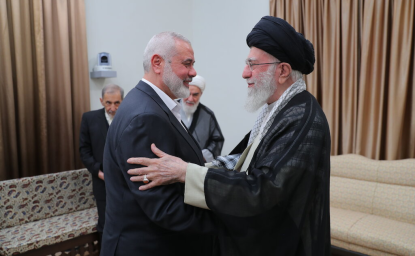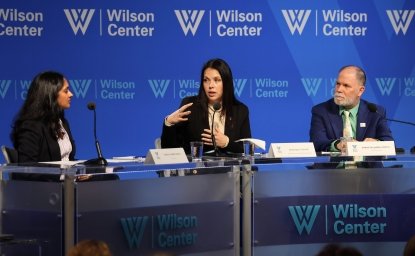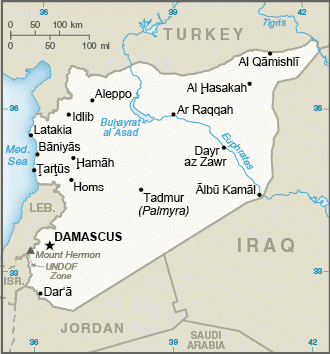
Syria has a long history with Islamist movements. The oldest is the Muslim Brotherhood, which dates back to the 1940s. Its conflict with the secular regime defined the poles in Syrian politics for more than six decades. It was crushed by the military after a failed uprising in the early 1980s. It became a movement bereft of any organized presence inside Syria. It leaders were in exile.
The uprising that erupted in 2011 produced a wider array of Islamist militias opposed to President Bashar Assad. The Muslim Brotherhood also re-emerged; it played a prominent role in creating a new opposition coalition abroad. It was the most influential force within the new Syrian National Council, established in Istanbul in 2011, and the Interim Syrian Government that set up a government-in-exile in Gaziantep in 2014. Inside Syria, rebel factions loyal to the Brotherhood, such as the Sham Legion, were minor players in an insurgency dominated by other Islamist groups that had superior military experience, better funding and deeper ties inside Syria.
Islamist rebels proliferated over the next three years. The spectrum included moderate Islamists, such as the Soldiers of the Levant in Damascus and the Mujahideen Army in Aleppo. Mainstream Salafis amassed in the Islamic Front. The two main hardline groups were the Islamic State of Iraq and Syria (ISIS) and the Nusra Front, which was affiliated with al Qaeda.
In 2014, Islamists conquered territory. Mainstream Islamists were the dominant force in the provinces of Aleppo and Damascus. The Nusra Front became the dominant force in Idlib province after routing U.S.-backed rebels. ISIS controlled the whole Euphrates Valley, in addition to swathes of desert in the center of the country. It declared a caliphate from the new Islamic State.
By early 2015, the Islamic State was the most formidable force in the country. It was simultaneously battling on four fronts against the other rebels, Kurdish nationalists, the U.S.-led coalition, and the Assad regime.
The Beginning
The Syrian branch of the Muslim Brotherhood was officially established after the withdrawal of the French colonial army from Syria in 1946. The early Syrian Brotherhood had no well-defined ideology. Its general goals were to defend Islamic norms and values against the rise of secular political forces, particularly in the realm of law. The Brotherhood also displayed striking flexibility and pragmatism from the start, however. In 1950, it lobbied for a constitutional provision that declared Islam to be “the religion of the state,” but the Brotherhood eventually rallied to the majority and voted instead for a constitution stating only that the president had to be a Muslim.
The Syrian Brotherhood also adopted ideas fashionable at the time, such as Arab nationalism and socialism. In 1949, Brotherhood members ran for elections under the name Socialist Islamic Front. Ten years later, Mustafa al Sibai published his seminal work, The Socialism of Islam. More conservative Islamists criticized this embrace of an “imported” ideology.
Between 1949 and 1963, Syria gyrated between parliamentary and military rule because of political coups and instability. The Brotherhood, which had little influence within the military compared to its secular rivals, was committed to restoring parliamentary rule. It also enjoyed decent relations with the bourgeois nationalist parties that dominated the political landscape during Syria’s so-called liberal age. Brotherhood members held ministerial positions in 1949 and 1961.
Unlike the early Egyptian Muslim Brotherhood, the Syrian branch was not a mass movement at that time. In 1961, it won its highest electoral victory with only 8.7 percent of parliamentary seats. It was actually a rather elitist organization with followers who were typically educated members of the traditional Sunni urban middle class and the sons of religious scholars, merchants, or craftsmen. It had a limited presence in rural areas. And it inevitably suffered from the political rise of the peasantry under the aegis of the Baath Party in the 1960s.
Banished
After the 1963 Baath Party coup, the Brotherhood faced a hostile, radically secularist regime. The movement was banned, and hundreds of its members went into exile. Among them was Isam al Attar, who succeeded Sibai as superintendent after Sibai’s death in 1964. The Brotherhood operated as a semi-clandestine group until the early 1980s, when it was basically eliminated inside the country.
Baathist repression also spawned frictions, which were based on regional ties that undermined the Brotherhood’s unity. In the early 1970s, Attar—who had fled to Germany from his base in Damascus—was challenged by the Aleppo branch, largely because of the strength of rival regional identities. The Aleppo wing was led by Abd al Fattah Abu Ghudda, a religious scholar who was recognized by the Egyptian mother organization as the legitimate superintendent.
Prolonged military rule forced the Brotherhood to develop a new strategy. It began proselytizing systematically among the long-neglected Syrian grassroots through a network of informal study circles. By the 1970s, it was able to take advantage of the Islamic revival that swept the Muslim world and recruited a growing number of educated young people.
The Brotherhood also took advantage of a small opening shortly after President Hafez al Assad seized power in a bloodless coup in 1970. But old tensions reemerged in the late 1970s as the Assad regime grew increasingly unpopular. The Brotherhood also elected a new superintendent, Adnan Sa’d al Din, from the hardline faction in the central city of Hama.
Armed Struggle
The confrontation eventually degenerated into armed struggle. Young Brotherhood activists had initially taken up arms in Hama in 1964, but they were easily suppressed by the regime and subsequently disavowed by their own leadership. The radical cell was led by Marwan Hadid, an engineer who eventually split from the organization as a result of its passivity.
After Hadid’s death in prison, his followers formed the Fighting Vanguard, or al Tali’a al Muqatila, and launched a campaign to assassinate state officials. In 1979, its massacre of dozens of Alawite cadets in the Artillery School of Aleppo plunged the country into turmoil. Popular uprisings erupted in the northern cities and large numbers of young people joined the Fighting Vanguard. In June 1980, military units, led by President Assad’s brother Rifaat, executed some 1,000 Islamists detained in a Palmyra prison to retaliate for a failed assassination attempt against the president. The regime then passed Law 49, which made membership in the Brotherhood a capital offense.
The Brotherhood’s attacks against the regime were far less effective than attacks by the Fighting Vanguard, which continued to carry out most of the assassinations and bombings. The Brotherhood had more influence outside Syria in generating media and political attention. Its propaganda sometimes had sectarian, anti-Alawite overtones, but its political objectives were unchanged. Its 1980 political program defined the ideal political system as a combination of liberal institutions and Islamic laws.
The denouement in the Islamist uprising played out in Hama, Syria’s fourth-largest city, in February 1982. The Assad regime responded by crushing the armed insurgency with heavy artillery bombardment and summary executions, killing thousands. By the mid-1980s, both the Brotherhood and the Fighting Vanguard networks were completely destroyed. The Vanguard ceased to exist, whereas the Brotherhood remained active in exile even though it was riven by splits between its Aleppo and Hama factions.
In Exile
With no prospects of toppling the regime, the Brotherhood’s main concern was retaining political relevance. In 1985, it agreed to meet Syrian security officials in Germany, but the talks ended in failure. In 1995, former Superintendent Abu Ghudda was allowed to visit Syria, but his request to meet with President Assad was ignored. More promising discussions were held in 1999, but they ended abruptly after the assassination in Aleppo of the go-between, Amin Yakan, a prominent former Brotherhood member.
During the same period, the Islamist group established parallel ties with the secular opposition. In 1982, it joined with the pro-Iraq wing of the Baath Party to form the National Alliance for the Liberation of Syria. The coalition lasted for a decade before disintegrating. The Brotherhood did not try again to unify the opposition until the presidential succession—when Hafez al Assad died and was replaced as president by his son Bashar al Assad in 2000—revived hopes for political reforms in Syria.
In 2001, two years after a Syrian-Jordanian rapprochement forced it to move its headquarters from Amman to London, the Brotherhood published the National Honor Pact. The document formally rejected the use of violence and called for dialogue among all Syrian political forces.
The Brotherhood began to be taken more seriously by interlocutors after the U.S. invasion of Iraq in 2003, which initially also left Syria feeling more vulnerable. The group sent positive signals to the regime, including a call by Superintendent Ali Sadr al Din al Bayanuni for a comprehensive national reconciliation.
In September 2004, United Nations Resolution 1559 increased international pressure on Damascus by calling for withdrawal of all Syrian forces from Lebanon. The Brotherhood, in turn, became more assertive. Three months later, it released the Political Project for Future Syria, its first detailed political program since 1980. The new project called for a regime that would be “republican and democratic” with liberal institutions but also “Islamic” because its constitution would make Islam the “religion of the state” and laws would be “gradually Islamized.”
Miscalculations and leadership
The assassination of former Lebanese Prime Minister Rafik Hariri in February 2005 dramatically affected Syria too. Lebanese protests forced Syria to withdraw its army after a 29-year occupation.
The shifting political tide allowed the Brotherhood to make spectacular inroads in rapprochement with secular opposition groups. It agreed to join the Damascus Declaration for Democratic Change, a broad alliance of political forces launched in October 2005. But the Brotherhood also soon miscalculated its position. In March 2006, Bayanuni and former Syrian Vice President Abd al Halim Khaddam, who had just defected, announced the creation of the National Salvation Front. This was an odd move for the Brotherhood. It forced a de facto break with members of the Damascus Declaration.
Khaddam was also far from being the right horse to back, despite his former position. He was perceived in Syria as one of the regime’s most corrupt figures. He had been marginalized for several years, leaving him little leverage inside the state apparatus. By the time the Front was created, the regime had also survived the most difficult phase of the Lebanese crisis. The Front emerged too late to capitalize on the political drama.
In 2009, the Brotherhood broke from the Front after the Gaza war between Israel and Hamas. It also announced a unilateral truce with the Assad regime, after which Damascus signaled it was ready to resume talks. The regime did not, however, follow through by lifting Law 49, which carried the death penalty for membership in the Brotherhood.
The setback led to a major leadership change. In 2010, the Aleppo faction lost out to the Hama faction in the Brotherhood’s internal elections. Bayanuni, who finished his third and final term, was replaced by Riyad Shuqfe as the new superintendent. Shuqfe, who had led the Brotherhood’s military unit in the early 1980s, was considered a hardliner. He opposed the group’s unilateral truce; he was about to ask the Consultative Council to renounce the truce when uprisings erupted in Tunisia and Egypt.
The 2011 uprising
After Syrians launched their own uprising in March 2011, the Brotherhood took a leading role in assembling the exiled opposition in the Syrian National Council. It was launched in August 2011. The Brotherhood was the only organized and experienced movement among an otherwise deeply fragmented opposition. It also had support from Qatar and Turkey. But its domination over the opposition in exile was contested. The Brotherhood’s immediate challenge was competition from rival Islamists who secured influential positions on the Syrian National Coalition, the Council’s successor, which was established in November 2012.
The rival Islamists included the Coalition’s first president, Sheikh Mouaz al Khatib. Khatib, a former preacher at the historic Umayyad Mosque, had special legitimacy since he had just left Damascus. Another rival was Imad al din al Rashid, former vice-dean of the Faculty of Sharia of Damascus. His Syrian National Movement, an alliance of secularists, moderate Islamists and Salafis, failed to recruit significant following. But one of its members, Badr Jamus, served as the Coalition’s General Secretary in 2014. A third rival was Anas al Abda, who secured a seat in the Coalition’s politburo in 2014. He had been president of the Movement for Justice and Development, a small group founded in London in 2006 that disintegrated after 2011.
A second threat to the Brotherhood was the opposition, even hostility, of Saudi Arabia, the United Arab Emirates and Jordan. All three countries tried to dilute the Brotherhood’s power within the Coalition by pushing for inclusion of secular Syrians and representatives of rebel groups. Their influence resulted in the selection of two pro-Saudi leaders—Ahmad al Jarba and Hadi al Bahra. They ran the Coalition from July 2013 to January 2015, when Riyadh’s disinterest in the opposition body led to the election of Khalid Khuja, who had pro-Turkish sentiment, to the presidency.
By avoiding confrontation with Saudi Arabia, the Syrian Brotherhood retained key positions in the Coalition, notably the vice-presidency, as well as influence over the Interim Government formed in March 2013. But it was no longer the kingmaker it had been in the first year of the uprising.
In 2014, the Brotherhood founded the political party Waad, an Arabic acronym for the National Party for Justice and the Constitution. Its leader, Muhammad Walid, resigned the following year to lead the Brotherhood. But the political initiative lost relevance as the civil war seemed to rage on indefinitely; military operations took precedence.
The Brotherhood tried to create alliances with various rebel factions, but it had limited success. The Committee for the Protection of Civilians (rebranded the Sham Legion in 2014) was a reasonably effective combat force in Idlib and Aleppo. The Committee of the Shields of the Revolution never held much sway. And the Syria Revolutionaries Front collapsed within weeks of its creation in 2012. The Brotherhood initially secured, but eventually lost the support of powerful rebel units, such as Suqur al-Sham in Idlib and the Tawhid Brigade in Aleppo.
New Islamist Players
In the absence of a popular base inside Syria, the Brotherhood partnered with pragmatic rebel units whose loyalty was determined largely by funding. But it was repeatedly marginalized by more powerful players: Regional states generally backed non-Islamist units fighting under the banner of the Free Syrian Army (FSA). And wealthy private donors in the Gulf supported Salafi factions.
The Sururi networks blended conservative Salafi religious doctrines with a moderate Brotherhood-like approach to political activism. They fostered creation of the Syria Islamic Liberation Front, which was dominated by the Suqur al-Sham and the Tawhid Brigade, alongside the Army of Islam in Damascus and the Faruq Brigades in Homs. Anti-establishment Salafis from Kuwait like Hajjaj al-‘Ajami funded the Syrian Islamic Front, which was dominated by Ahrar al Sham. As for quiescent, Saudi-aligned Salafis, they backed the Front for Authenticity and Development and, later, the Army of Islam.
In 2013-14, mainstream Islamist factions further united into several new alliances: The Syrian Islamic Liberation Front and the Syrian Islamic Front merged into the Islamic Front. Moderate Islamist factions with loose ties to the Brotherhood founded the Soldiers of the Levant in Damascus and the Army of the Mujahideen in Aleppo. The Soldiers of the Levant and the Army of Islam formed a joint command structure. And the Aleppo branches of the Islamic Front, Front for Authenticity and Development, and the Army of the Mujahideen united to form the Levant Front.
Among the Islamists, the two most powerful jihadi groups by 2015 were the Nusra Front and the Islamic State. Both had ties extending well beyond Syria. Both were part of the jihadi internationalism, with foreign fighters and international networks. Both originally had ties to al Qaeda. But they also best reflected the rivalries among Islamists, even among those that shared similar ideologies and goals.
The Nusra Front was established in early 2012 as a Syrian front organization for the Islamic State in Iraq (ISI). In April 2013, ISI leader Abu Bakr al Baghdadi proclaimed a formal merger of Nusra and ISI into the Islamic State in Iraq and Sham (ISIS). But the Syrian franchise had grown increasingly autonomous from its Iraqi counterpart. Nusra leader Abu Muhammad al Julani spurned the merger. The rejection precipitated a divorce between ISIS and al Qaeda, whose leadership condemned Baghdadi’s decision and accepted Julani’s pledge of allegiance. From then on, Nusra was more formally known as the Al Qaeda Organization in the Levant.
Even before their falling out, the leaders of Nusra and ISIS had conflicting strategies: Nusra worked alongside other rebel factions on the battlefield as well as in local governance, such as in Aleppo’s Islamic Committee. ISIS was exclusive. It even moved against other rebels in a quest to control territory, seizing a string of towns along the Turkish border. Its tactics proved costly. In January 2014, a rebel alliance that included both Nusra and the Free Syrian Army launched an offensive against ISIS. ISIS was expelled from northwest Syria. It then turned on the other rebels.
By June 2014, ISIS had taken most of two Syrian provinces, Raqqah and Deir Ezzor. It then launched a blitzkrieg offensive across Iraq’s Sunni provinces. Its conquest of major cities and large chunks of land led the militia to declare proclaim the re-establishment of the Caliphate, and rename itself the Islamic State. The spectacular ISIS successes on the ground prompted a change in Nusra’s strategy. In northern Syria it curtailed collaboration with other rebel groups, created its own judicial bodies for local governance, and turned its guns on two U.S. and Saudi-backed groups – the Syria Revolutionaries Front and the Hazm Movement -- in the province of Idlib. Nusra, too, took significant territory by the end of 2014.
Key Positions
The positions of the Muslim Brotherhood and of the other Islamists operating within the Syrian National Coalition are consistently more moderate than those of Salafi rebel groups, especially the jihadis.
Islam and Democracy
In its 2004 program, the Brotherhood stated clearly that it had not given up the goal of establishing an “Islamic state” through the “gradual Islamization of laws.” But it called its ideal state “civilian” and not theocratic. Indeed, it said that the government should be formed by and be accountable to a parliament that is renewed regularly through multiparty elections. In order words, the Brotherhood supports democratic control over the executives, but it puts limits on the democratic character of law-making, since the decisions of an elected parliament should be bounded by the limits of sharia.
In 2014, mainstream Islamist factions (including Ahrar al Sham) released an Honor Charter in which they vow to establish a “state of law, freedom and justice” and respect “human rights.” These groups do not fully agree on the specifics, however. Some harbor views similar to the Brotherhood’s, while Ahrar al Sham never clearly declared its acceptance of popular elections. Hardline jihadis flatly rejected any form of popular sovereignty and proposed a model of governance akin to one-party rule.
Women’s Rights
On personal status law, the Brotherhood is not willing to fundamentally challenge the Sharia-based legal framework in Syria. On social and political rights, the 2004 document stated that “it is not forbidden for a woman to become a judge, an administrator, or a minister.” The group encourages women to dress “modestly” without specifying if the dress code should be enforced by the state.
Among rebel factions, positions on women’s rights vary widely. Some accept the Brotherhood’s views. Others, such as the Islamic State, favor severe restrictions on freedom of movement and enforcement of a strict dress-code.
Religious Minorities
The Brotherhood and other moderate Islamists believe the classical Islamic concept of dhimma, or legal inferiority for non-Muslims, should be replaced by the modern notion of citizenship. The Brotherhood does not seek to change Syria’s existing personal status law for Christians, which grants them significant autonomy. In terms of political rights, the Brotherhood unequivocally backed equality between Syrian citizens regardless of their religion in the Pledge and Charter released in 2012. It states that “any citizen has the right to occupy the highest positions on the basis of election and competence.”
Mainstream Islamist factions broadly agree with the Brotherhood’s views, although some insist on keeping a constitutional provision requiring the president to be a Muslim. The harder-line Ahrar al-Sham suggested that it would not accept non-Muslims in ministerial position. And the Islamic State imposed severe limits on Christians, imposing a jiziya or protection tax and desecrating churches.
As a result of sectarian polarization in the conflict, many rebel groups adopted anti-Alawite and anti-Shiite rhetoric. Some attacked Alawite residential areas. But in the Honor Charter, mainstream Islamist rebels pledged to bring “freedom, justice and security to the entire Syrian society with its diverse multi-ethnical and multi-sectarian social fabric.” They also committed themselves to avoid any acts of “revenge and retaliation,” and to offer “fair trials” to those who participated in crimes of the regime.
Ethnic Minorities
The issue of ethnic minorities is theoretically less problematic than that of religious minorities, because the largest share of Syrian ethnic minorities (Kurds, Turkmens, and Circassians) are Sunni Muslims. The Brotherhood and mainstream Islamist rebels oppose Kurdish self-determination and describe the territorial integrity of Syria as non-negotiable. Several rebel groups have fought with Kurdish nationalist factions for the control of the resource-rich northeastern part of the country. Since 2014, the anti-Kurdish side of the conflict was essentially limited to the Islamic State.
The United States and the West
The Brotherhood is not fundamentally hostile to the West, partly because much of its leadership is based in Western countries and partly because it opposes a regime that traditionally had tense relations with the West. But the Brotherhood has criticized the U.S. invasion of Iraq and America’s “unlimited” support for Israel. Within the framework of the Syrian National Coalition, the Brotherhood and other Islamists have worked in cooperation with the United States. In the Honor Charter, mainstream Islamist rebels welcome cooperation with regional and international parties that “show solidarity with the Syrian people.” In 2014, they expressed disappointment that the U.S.-led military campaign against the Islamic State did not also target Assad’s regime forces.
Israel
The Brotherhood does not officially recognize Israel. Its program seeks to “counter the Zionist project in its different aspects”—a position unlikely to change before an Israeli withdrawal from the Golan Heights. The group has also traditionally supported Hamas, the Palestinian Islamist movement that also emerged from Egypt’s Muslim Brotherhood. Mainstream Islamists share this hostility to Israel, but some of their leaders have suggested that it is up to the Syrian people to decide Syria’s future stance.
The Future
In 2015, the real issue is whether or not the Syrian state will survive. Islamists have already changed Syria more radically than at any time since it was founded. The Islamic State controls large swathes of territory that are bound to be governed by Islamist factions for years to come. A second major issue is what brand of Islamism will ultimately prevail.
The mainstream Islamists face three huge challenges to survive and retain relevance: The first is from Assad’s forces, which struck major blows particularly around Damascus and Aleppo. The second is preserving a modicum of law and order in the areas they control, since failure provided fertile ground for extremists, notably the Islamic State. The third is checking jihadi militants. To counter the extremists’ edge, mainstream Islamists will have to prepare for new offensives by the Islamic State; close ranks against Nusra; and ensure that Ahrar al Sham continues to plays its role of “swing-voter” in their favor.
Thomas Pierret is a lecturer in contemporary Islam at the University of Edinburgh. He is the author of Religion and State in Syria (Cambridge University Press, 2013).
Photo credits: Bashar al Assad by Fabio Rodrigues Pozzebom / ABr [CC BY 3.0 br (http://creativecommons.org/licenses/by/3.0/br/deed.en)], via Wikimedia Commons; Islamic State flag by Global Panorama [CC 2.0 https://creativecommons.org/licenses/by-sa/2.0/], via Flickr commons

The Islamists
Learn more about Hamas and how it relates to similarly aligned organizations throughout the region. Read more

Explore More
Browse Insights & Analysis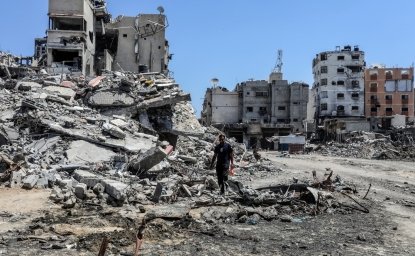
Israel Escalates Attacks in Gaza: What’s Next?
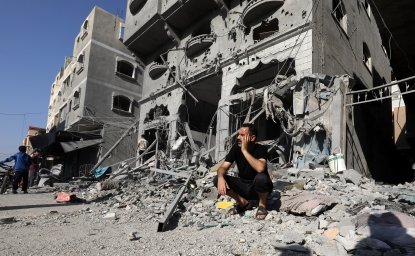
Israel Expands Operations on Multiple Fronts: Perspectives on the Conflict
